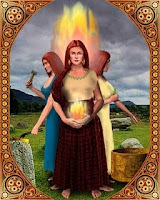 We are now halfway between the Winter Solstice (December 21) and the Vernal or Spring Equinox (March 20). It's called a cross-quarter day and is known as Imbolc (or some variation of that spelling) in the Celtic world It's also a modern Neopagan celebration and part of the Wheel of the Year.
We are now halfway between the Winter Solstice (December 21) and the Vernal or Spring Equinox (March 20). It's called a cross-quarter day and is known as Imbolc (or some variation of that spelling) in the Celtic world It's also a modern Neopagan celebration and part of the Wheel of the Year.Imbolc is most commonly celebrated on February 2 (same as Groundhog Day and Candlemas on the Christian calendar) but it actually occurs, according to the position of the Sun on the ecliptic, at 11:20 pm EST on Thursday, February 3 this year.
This cross-quarter day has been known since antiquity - a 5,000 year-old Neolithic passage tomb at the Hill of Tara in County Meath, Ireland has an alignment with sunrise on Imbolc. The word Imbolc comes from the Celtic i mbolg or "in the belly" referring to pregnant ewes who soon give birth to spring lambs. It was viewed as the start of spring (even though snow may yet be on the ground), a time for weather prognostication, and to watch for animals emerging from their winter dens (sound familiar? Groundhog Day has its roots in similar Germanic pagan beliefs).
One traditional Irish legend regarding Imbolc is about the Cailleach, the old hag. If the Cailleach knows winter will last for a while yet, she will make sure the weather on Imbolc is bright and sunny so she can gather plenty of firewood. If Imbolc is a day of foul weather it means the Cailleach is asleep and winter is almost over. Very similar to the groundhog and his shadow! The weather was pretty nasty so I guess spring will arrive soon!
 Imbolc is sacred to Brigid (also with many alternate spellings), a Celtic goddess. She's associated with fire, fertility, poetry, healing, and smithcraft. She's typically honored on Imbolc with offerings, requests for blessings, and the lighting of sacred fires. Imbolc is traditionally a time to reflect on where your life is going as we move into the next part of the year.
Imbolc is sacred to Brigid (also with many alternate spellings), a Celtic goddess. She's associated with fire, fertility, poetry, healing, and smithcraft. She's typically honored on Imbolc with offerings, requests for blessings, and the lighting of sacred fires. Imbolc is traditionally a time to reflect on where your life is going as we move into the next part of the year.Crafts for Imbolc include making corn dollies and weaving a Brigid's cross from rushes. When Ireland was Christianized in the 5th century, the goddess Brigid morphed into St. Brigid of Kildare and Imbolc is now often called St. Brigid's Day although many of the old pagan practices persist.
The Christian holiday of Candlemas is celebrated at the same time and is believed to be the time when Mary presented Jesus to God at the Temple in Jerusalem after observing the traditional 40-day period of purification for new mothers (Luke 2:32). Many of the traditions of Candlemas have a similarity to pagan Imbolc practices perhaps implying an effort to superimpose Christianity on ancient pagan beliefs.




Thank you! I live in Pennsylvania and previously had no idea where folks who live in the middle of nowhere would have come up with the idea of a groundhog and his shadow predicting the weather. I'll share this with my class this morning. I teach Classical Mythology at a community college, and although Celtic Mythology isn't my specialty, I enjoy learning about it.
ReplyDeleteWow, I ran across your blog while looking for Equinox images. Thanks for some great information.
ReplyDelete